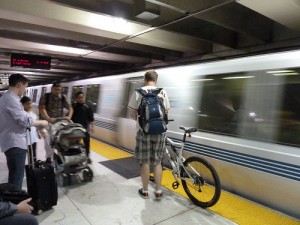You could call it BART's Great Rush-Hour Bike Experiment.
For five days starting Monday, the transit agency will be open to bikes on all lines, all day long. It's a long way from the days when to ride on BART, cyclists had to go down and apply in person for a permit at the Lake Merritt Station--but only during certain hours. When you paid your fee, you got a little green BART bike permit. To ride a train, you had to show the permit to the station agent before you went through the fare gates. And it seemed like the agents would always find a reason to bark at you about something: "Use the stairs! Not the escalator!" Oh, yeah—those were the days.
The system has become much friendlier to cyclists since then. No permits, no fees, no scoldings from the agents. And next week's rush-hour bike trial aims to answer questions about what will happen if cyclists can get on any train any time they want, even when BART is crammed with commuters. Not to get too carried away, the rush-hour bike trial will have some rules. Perhaps most important: no bikes in the first three cars of a train during the heaviest commute hours (the usual rule is the lead car is off-limits on all trains).

BART also suggests bicyclists use common sense: Don't try to board cars that are already jam-packed with commuters.
Ridership has risen steadily and is near an all-time high, with about 400,000 commuter trips per weekday. So gauging rider feedback on attitudes towards bicyclists trying to squeeze into standing-room-only train cars during rush hour will be a key measure of success, and BART will ask passengers to take a survey (on the agency's website)about their experience during the pilot week.